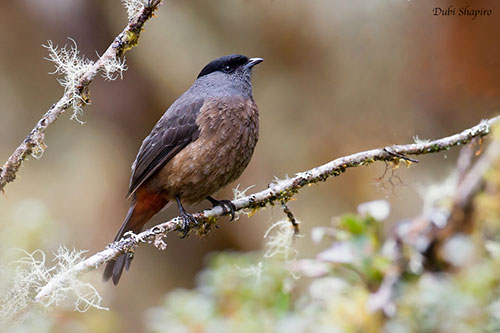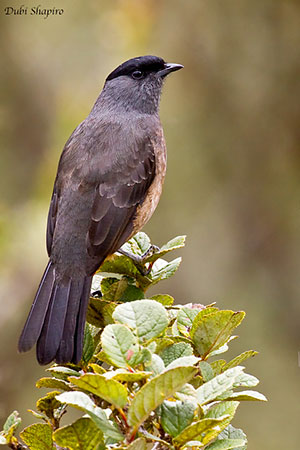
Fr: Cotinga de Sclater
Ang: Bay-vented Cotinga
All: Braunbauchkotinga
Esp: Cotinga de Sclater - Cotinga de Subcaudales Bayas
Ita: Cotinga culbaio
Nd: Sclaters Cotinga
Sd: perukotinga
Photographers:
Roger Ahlman
Pbase Galleries Peru and Ecuador
Dubi Shapiro
Dubi Shapiro Photo Galleries
Text by Nicole Bouglouan
Sources:
HANDBOOK OF THE BIRDS OF THE WORLD Vol 9 - by Josep del Hoyo - Andrew Elliot - David Christie - Lynx Edicions - ISBN: 8487334695
BIRDS OF PERU by Thomas S. Schulenberg, Douglas F. Stotz, Daniel F. Lane, John P. O’Neill, Theodore A. Parker III – Princeton University Press 2007– ISBN: 978-0-691-13023-1
BIRDS OF SOUTH AMERICA – Passerines - by Robert S. Ridgely and Guy Tudor – HELM Field Guides – ISBN: 9781408113424
Neotropical Birds – Cornell Lab of Ornithology
Wikipedia, la enciclopedia libre
CREAGUS@Monterey Bay (Don Roberson)
Bay-vented Cotinga
Doliornis sclateri
Passeriformes Order – Cotingidae Family
INTRODUCTION:
The Bay-vented Cotinga is endemic to C Peru where it is present between 2,600 and 3,800 metres of elevation on the E slope of the Andes. It is restricted to woodland near the treeline where it is rare and local in humid montane forests.
It feeds primarily on fruits of Escallonia trees and also consumes some insects and occasionally seeds. It is usually seen alone or in pairs, but the breeding behaviour is poorly known.
The Bay-vented Cotinga is affected by degradation of its forest habitat throughout the range. The population is slowly declining and the species is currently classified as Vulnerable.
DESCRIPTION OF THE BIRD:
Biometrics:
length: 21-22 cm
Weight: M: 54-69 gr – F: 53-67 gr
The Bay-vented Cotinga male has black lores, forehead and crown, with semi-concealed maroon-rufous nuchal crest. Face, chin, throat and mantle are grey, whereas rest of upperparts is dark greyish but browner on wings and tail.
The underparts are brown. The undertail-coverts are bright reddish-brown, giving the bird its English name.
The two-tone bill has black upper mandible and blue-grey lower mandible. The eyes are grey. Legs and feet are dark grey.

The female resembles male but she lacks the black crown. She has grey crown and forehead but lores are black.
The juvenile resembles adult female but it appears slightly browner, with indistinct olive-brown streaking. The crown is grey. The bright-coloured crest is absent.
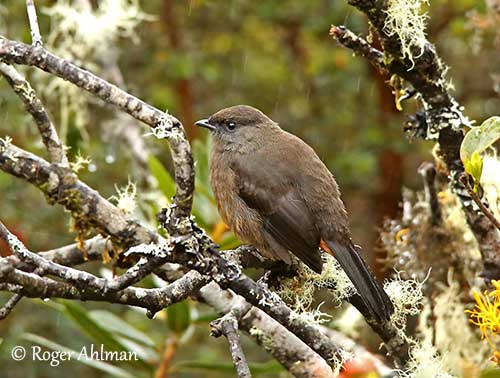
RANGE:
The Bay-vented Cotinga is found in C Peru on the E slope of the Andes, from central San Martín S to Junín.
HABITAT:
The Bay-vented Cotinga is usually rare and local in montane elfin forest. It is restricted to high elevations along the east crest of E Andes, between 2,600 and 3,800 metres.
This species prefers low trees with dense, flat canopies, especially Escallonia and Weinmannia species.
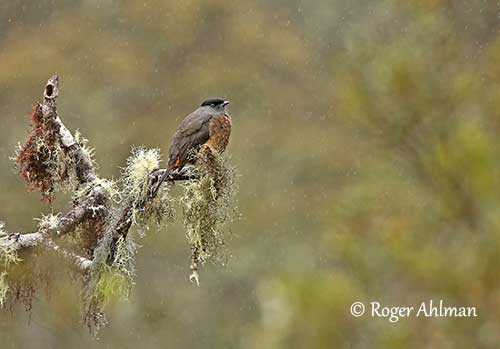
CALLS AND SONGS: SOUNS BY XENO-CANTO
The Bay-vented Cotinga is usually silent, but it sometimes produces a raspy call “shhh” varying in length and intensity.
The presumed song is a mewing, rising “rhee” or “rhee-ah” usually louder and scratchier than the song of the Red-crested Cotinga.
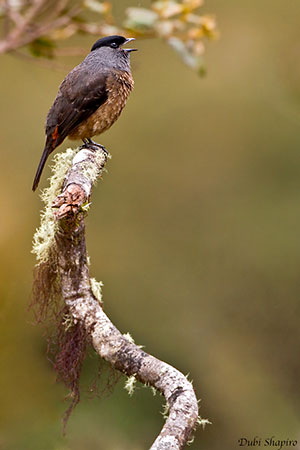
BEHAVIOUR IN THE WILD:
The Bay-vented Cotinga forages in humid montane forest and humid scrub.
It feeds primarily on fruits and berries, especially the fruits of Escallonia trees, native from South America. Some seeds and insects are also part of the diet.
The Bay-vented Cotinga is generally seen alone or in pairs. It often perches atop of low trees or shrubs in the early morning, but it remains within the cover for the rest of the day.
The breeding behaviour is poorly known. A male was observed displaying, performing head-bobbing display, probably to enhance the bright-coloured nuchal crest.
Most Cotingidae species are polygynous, but nothing is known about the present species.
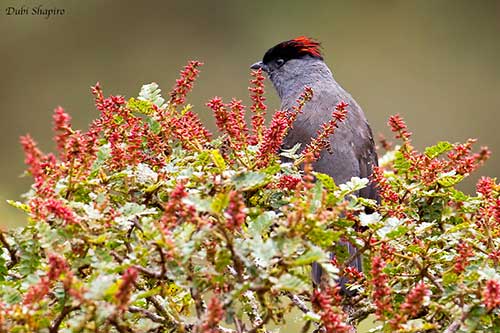
The Bay-vented Cotinga is resident and sedentary.
It may fly over 50 metres or more when disturbed after dropping from a perch. Then, it lands on another exposed perch.
REPRODUCTION OF THIS SPECIES:
An occupied nest was seen in April or May in Huánuco, but it was not described.
It was probably an open cup, a typical structure in Cotingidae family, placed four metres above the ground at woodland edge.
A juvenile was collected in July.
No more information.
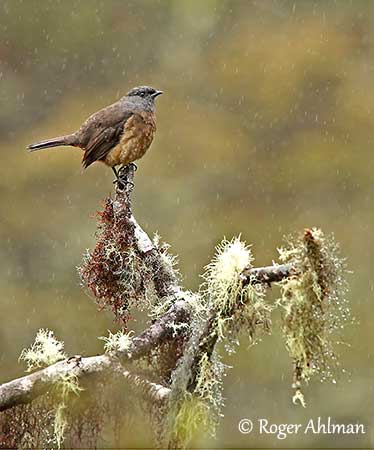
PROTECTION / THREATS / STATUS:
The Bay-vented Cotinga is a restricted-range species. It is affected by the degradation of the habitat.
This species favours unburnt treeline habitat, but it is now rare and has been seriously degraded and reduced throughout the range by fires to maintain pastureland. Unsustainable agricultural techniques occur also inside protected areas, involving 50% of habitat loss in some areas.
The population is roughly estimated to number 1,500/7,000 mature individuals and is slowly declining.
The Bay-vented Cotinga is currently listed as Vulnerable.
